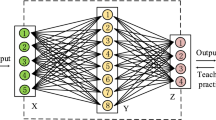Abstract
Path planning (PP) is a hot topic in the field of robotics, and neural networks (NNs) and computer vision technologies are widely used in the PP of robots. In this paper, the application of robot PP is classified, compared and analyzed, the autonomous dynamic obstacle avoidance of the robot in the dynamic obstacle environment is realized, and the particle swarm algorithm is used to find the global optimal path. In this paper, a fuzzy optimization algorithm for PP of visual robots is proposed. The algorithm is based on predictive control rolling optimization, and expresses the system optimization goals and constraints by membership, so as to realize the multi-objective optimization problem. Simulation experiments show that the proposed algorithm is effective. The experimental results show that compared with the traditional PP of the robot based on NN, the NN can find the shortest path for the robot in the dynamic avoidance of obstacles, which greatly optimizes the avoidance time. Therefore, it is very valuable to use NNs and computer vision technology to study PP.
J. Wen, J. Chen, J. Jiang, Z. Bi, J. Wei—These authors contributed equally to this work.
Access this chapter
Tax calculation will be finalised at checkout
Purchases are for personal use only
Similar content being viewed by others
References
Shorakaei, H., Vahdani, M., Imani, B., et al.: Optimal cooperative path planning of unmanned aerial vehicles by a parallel genetic algorithm. Robotica 34(4), 823–836 (2016)
Zhou, Y., Wang, R.: An improved flower pollination algorithm for optimal unmanned undersea vehicle path planning problem. Int. J. Pattern Recognit. Artif. Intell. 30(4), 1659010.1–1659010.27 (2016)
Subramani, D.N.: Energy optimal path planning using stochastic dynamically orthogonal level set equations of technology by signature redacted signature redacted energy optimal path planning using stochastic dynamically orthogonal level set equations. Deep-Sea Res. Part II 56(3), 68–86 (2017)
Kovacs, B., Szayer, G., Tajti, F., et al.: A novel potential field method for path planning of mobile robots by adapting animal motion attributes. Robot. Auton. Syst. 82(C), 24–34 (2016)
Wang, G.G., Chu, H.C.E., Mirjalili, S.: Three-dimensional path planning for UCAV using an improved bat algorithm. Aerosp. Sci. Technol. 49(FEB), 231–238 (2016)
Bo, Z., Duan, H.: Three-dimensional path planning for uninhabited combat aerial vehicle based on predator-prey pigeon-inspired optimization in dynamic environment. IEEE/ACM Trans. Comput. Biol. Bioinf. 14(1), 97–107 (2017)
Chen, Y.B., Luo, G.C., Mei, Y.S., et al.: UAV path planning using artificial potential field method updated by optimal control theory. Int. J. Syst. Sci. 47(6), 1407–1420 (2016)
Song, B., Wang, Z., Li, S.: A new genetic algorithm approach to smooth path planning for mobile robots. Assem. Autom. 36(2), 138–145 (2016)
Conesa-Munoz, J., Pajares, G., Ribeiro, A.: Mix-opt: a new route operator for optimal coverage path planning for a fleet in an agricultural environment. Expert Syst. Appl. 54(Jul), 364–378 (2016)
Greene, R.L., Lu, M.L., Barim, M.S., et al.: Estimating trunk angle kinematics during lifting using a computationally efficient computer vision method. Hum. Factors: J. Hum. Factors Ergon. Soc. 64(3), 482–498 (2022)
Bjerge, K., Mann, H., Hye, T.T.: Real-time insect tracking and monitoring with computer vision and deep learning. Remote Sens. Ecol. Conserv. 8(3), 315–327 (2022)
Li, H., Spencer, B.F., Bae, H., et al.: Deep super resolution crack network (SrcNet) for improving computer vision–based automated crack detectability in in situ bridges. Struct. Health Monit. 20(4), 1428–1442 (2021)
Noreen, K., Umar, M.: Computer vision syndrome (CVS) and its associated risk factors among undergraduate medical students in midst of COVID-19. Pak. J. Ophthalmol. 37(1), 102–108 (2021)
Wang, L., Xu, R., Yu, F.: Genetic nelder-mead neural network algorithm for fault parameter inversion using GPS data. Geodesy Geodyn. 13(4), 386–398 (2022)
Aslam, M., Munir, E.U., Rafique, M.M., et al.: Adaptive energy-efficient clustering path planning routing protocols for heterogeneous wireless sensor networks. Sustain. Comput. Inform. Syst. 12(DEC), 57–71 (2016)
Wu, K., Esfahani, M.A., Yuan, S., et al.: TDPP-Net: achieving three-dimensional path planning via a deep NN architecture. Neurocomputing 357, 151–162 (2019)
Li, K., Yuan, C., Wang, J., et al.: Four-direction search scheme of path planning for mobile agents. Robotica 38(3), 531–540 (2020)
Sun, L.: A real-time collision-free path planning of a rust removal robot using an improved neural network. J. Shanghai Jiaotong Univ. (Sci.) 22(005), 633–640 (2017)
Author information
Authors and Affiliations
Corresponding author
Editor information
Editors and Affiliations
Rights and permissions
Copyright information
© 2023 The Author(s), under exclusive license to Springer Nature Switzerland AG
About this paper
Cite this paper
Wen, J., Chen, J., Jiang, J., Bi, Z., Wei, J. (2023). Application of Computer Vision Technology Based on Neural Network in Path Planning. In: Xu, Z., Alrabaee, S., Loyola-González, O., Cahyani, N.D.W., Ab Rahman, N.H. (eds) Cyber Security Intelligence and Analytics. CSIA 2023. Lecture Notes on Data Engineering and Communications Technologies, vol 172. Springer, Cham. https://doi.org/10.1007/978-3-031-31860-3_22
Download citation
DOI: https://doi.org/10.1007/978-3-031-31860-3_22
Published:
Publisher Name: Springer, Cham
Print ISBN: 978-3-031-31859-7
Online ISBN: 978-3-031-31860-3
eBook Packages: Intelligent Technologies and RoboticsIntelligent Technologies and Robotics (R0)




